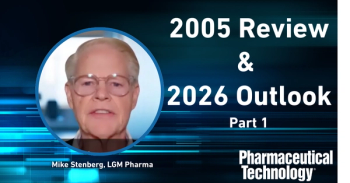
Equipment and Processing Report
- Equipment and Processing Report-10-21-2015
- Issue 12
Understanding the Flow Behavior of Materials
A rheometer and powder flow tester can measure how pharmaceutical materials, such as powders from a hopper, flow.
Analyzing the rheology or flow behavior of materials involves evaluating initial movement to flow under different conditions to a final state when flow ceases and the material holds its final position. Whether the product is a liquid, cream, paste, or powder, flow analysis is needed to show the product’s ability to pump, mix, transfer, store, and fill. Use of pharmaceutical products by humans also requires flow analysis because the consumer will use a variety of actions to spread ointments, chew pills, and swallow liquids.
Measuring material with a rheometer
Scientists use flow curves to show how materials move. The control parameter that causes movement for liquids and semi-solids is shear rate, which can be graphed vs. resistance to movement (i.e., viscosity or shear stress as shown in Figure 1).
Using a cone/plate rheometer, shown in Figure 2, a sample is placed on the plate, which is temperature controlled, and the cone spindle with its virtually flat bottom comes down to make contact. The instrument has the capability of shearing the material over a continuously broad range of shear stresses and/or shear rates and can handle many types of materials, ranging from thin liquids (e.g., eye solutions) to viscous semi-solids (e.g., petroleum jelly and other skin ointments). A rheometer can perform a battery of tests, such as yield stress measurement when the material is at rest, full viscosity flow curve with thixotropy calculation (i.e., time sensitivity to being sheared) when the material is in motion, creep/recovery (i.e., low force flow behavior), and temperature profiling (i.e., how the viscosity property changes with temperature).
Measuring powder flow from a hopper
For powders in a bin or containment vessel, consolidating stress is the driving force and reflects the self-weight of the powder pushing down on the material in the hopper section to force it out the bottom. Figure 3 shows a graph of consolidation stress vs. resistance to movement (i.e., failure strength).
The data in this graph are measured using a standard flow function test with a powder flow tester and a shear cell, as shown in Figure 4. A powder sample is placed in the trough which then sits on a turntable in the powder flow tester. The lid (vane-type with pockets) comes down on top of the trough and compresses the powder. The trough rotates through a very small angle and measures the frictional force between powder particles in the trough and those trapped in the vane pockets. This measurement analyzes the force needed to allow relative movement between particles (i.e., flow discharge out the bottom of the hopper in a bin or containment vessel).
Most hoppers operate in “core” or “funnel” flow. The material at the topmost level in the hopper moves down through the center of the hopper and discharges before the material around the outside, so that the last powder put into the hopper is the first to discharge. The material around the outside experiences some degree of compaction while it waits its turn to flow out. Sometimes, this compaction may be sufficient to prevent the powder from discharging when its turn finally comes to start flowing. Powder testing can predict this degree of compaction (i.e., rathole diameter) as well as the “arching dimension”, which is a prediction of whether the powder has enough strength to bridge the hopper opening. These numbers can be helpful in determining whether the hopper will experience flow problems.
About the Author
Robert G. McGregor is general manager, Global Marketing & High-End Lab Instrument Sales at Brookfield Engineering Laboratories,
Articles in this issue
about 10 years ago
Giving a Boost to the Facility of the Futureabout 10 years ago
Partnering to Address ParticulatesNewsletter
Get the essential updates shaping the future of pharma manufacturing and compliance—subscribe today to Pharmaceutical Technology and never miss a breakthrough.




